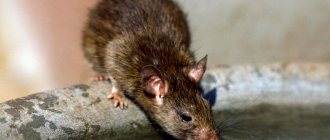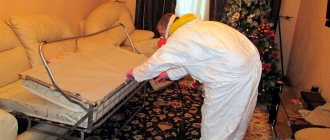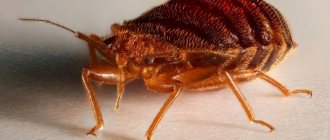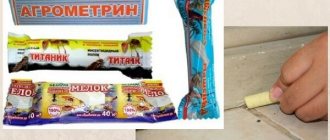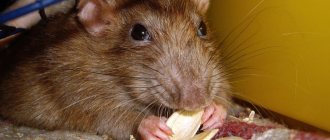Insects, pathogens, rodents and other small animals are unwanted “neighbors” of people that you want to get rid of simply because they are unpleasant to look at. In some cases, this is necessary to ensure safety for human existence. To get rid of unwanted “neighbors”, various measures are taken depending on the biological class of animals:
- disinfection - methods of destroying bacteria, viruses, fungi and mold;
- deratization - methods of getting rid of rodents and other small animals that can harm people, production, including agricultural production, or supplies;
- disinsection - the destruction of unwanted insects of any kind both in buildings and in fields and gardens.
When disinfection is needed, and when deratization or disinfestation is needed, the residents of the house or a certain area decide, depending on how much the unwanted “neighbors” interfere with the comfort and safety of people. In some cases, they are carried out in accordance with sanitary requirements.
Disinsection: types, methods
In order for a house to be cozy and living in it comfortable, it must, first of all, be clean. However, this is impossible if the unpleasant neighborhood consists of insects or rodents.
The presence of bedbugs, cockroaches or mice is not only unpleasant, but can have a detrimental effect on the health of residents. You can get rid of unexpected guests by disinfestation and deratization
Disinsection is a method of destroying pest insects, including their colonies.
Disinsection can be divided into 2 types:
- preventive, i.e. involving the creation of unfavorable conditions for insects to live; the complex involves constant cleaning, blocking the paths of insects entering the home;
- fighter , i.e. using poisons dangerous to insects.
Disinfection, disinfestation, deratization: main differences and what you need to know
2018-07-16 City Disinfection Station
Disinfection, disinsection, deratization are the names of procedures that the average person knows little about. And for many, it is even more difficult to distinguish between these concepts. All of them are in one way or another connected with the release of residential or commercial premises from uninvited “guests”.
When various insects or rodents appear on the territory or premises used by people, it causes discomfort. And often their discovery is like a real disaster. It is clear that you cannot be insured against the appearance of parasites anywhere; they can pay a visit either to a forgotten garage or to a five-star hotel, and in each case people will be disgusted by their presence.
Such a reaction is natural, since the presence of bedbugs, cockroaches, rats and other creatures is not only an aversion, but also a real danger to a person or animal. Of course, to varying degrees, but still their presence in residential or non-residential premises is not desirable. They can provoke various diseases and can be harmful to health.
After encountering a similar problem, people understand that it is very difficult to completely get rid of any parasites on their own, it is an almost impossible task. This requires knowledge and experience, only then will there be a result.
It is important to understand what needs to be done and how. The premises may need to be disinfected. Or maybe deratization is needed. Or pest control. How to understand what exactly to do if many do not understand what such concepts mean?
The choice depends on what pests you have in your living or other space. Each type has its own method of destruction and its own preparations.
What is disinfection
But what is disinfection, and what kind does it happen? This concept refers to disinfection, and it refers to complex measures that make it possible to destroy the causative agents of all kinds of infectious diseases in the external environment, as well as the removal of toxins that can cause colossal harm.
Situations are different, so disinfection is divided into several types:
- To prevent, that is, prevent preventive diseases, a preventive version of disinfection is carried out, and this is done periodically. Such events are usually needed in places where there are many people. And it is very important to spend them where children are always present. Their bodies continue to grow and develop, and they are very susceptible to viruses and harmful bacteria.
- When an infection has already occurred, ongoing disinfection is carried out so that it can spread further. The measures will restrain the development of the disease within certain limits until it is completely eliminated.
- There is also a final disinfection. Its task is to completely free a certain area from pathogens; it is carried out when the objects have fully recovered and are hospitalized.
Considering the focus of different types of disinfection, it is easy to conclude that one’s own efforts are sufficient to carry out preventive measures, but it is better to entrust the rest to professionals. Only experienced specialists will be able to perform them correctly.
What are the methods?
They clean rooms, ridding them of viruses, using different methods, three of them are most often used:
- Mechanical . This is the simplest, but at the same time, reliable method of carrying out disinfection work. This kind of work can reduce the number of harmful bacteria, but it will not help destroy them completely. What does the method include? Frequent, on a regular basis, washing linen and clothes, washing hands, picking up garbage and removing it, and other preventive measures.
- Physical . It usually refers to a specific object. Its essence is the use of high temperature, and this includes boiling, hot steam treatment, and heating. This method also includes exposure to ultraviolet radiation, that is, quartz treatment, as well as working with a bactericidal lamp.
- Chemical. This is the most reliable method, it is performed using chemicals. The most often chosen solutions contain chlorine; they necessarily contain anolyte or bleach, as well as chloramine or other similar components.
Now everything is clear about disinfection, and you need to decide on two other concepts.
What is pest control
For those who do not know what pest control is, there is a simple answer: this is what they call the destruction of unwanted insects. This is the disinfection of the territory, its complete ridding of insects that can carry the infection. Work is carried out using certain chemicals, hot steam treatment and the use of biological substances are also relevant.
During the disinfestation process, insects can be destroyed whose presence in a room near people is not desirable. As a rule, mosquitoes or flies are not welcome, ants will be uninvited “guests,” and cockroaches, bed bugs and others are not welcome.
Disinsection is work aimed at the complete destruction of insects (infected, harmful).
Disinsection also varies; it is divided into several types:
- Full . It is carried out using special chemicals that are lethal to certain types of insects whose presence is not desirable. They are completely destroyed in a given area.
- Preventive. It prevents the occurrence of such a problem, for which substances are used that can create uncomfortable conditions that do not allow insects to appear and develop. We are talking about bedbugs or lice, fleas, cockroaches and so on.
Preventive measures are considered:
- creating cleanliness in the room and constantly maintaining it;
- the use of mosquito nets on open windows and doorways;
- Frequent cleaning and garbage removal.
Disinsection methods can be different, they differ in the degree of impact:
- Mechanical. This is the cleaning and washing described above, that is, the cleanliness of the room.
- Physical. When choosing this method, they work with hot steam and ultraviolet light, and, if necessary, direct fire.
- Biological. This method allows you to use other animals to kill parasites. As a rule, these are birds.
- Chemical. The use of chemicals that destroy insects or create conditions for them that are unfavorable for their appearance and development. These are chlorine-containing mixtures.
What is deratization
What is deratization? These are measures that are aimed at destroying the emerging rodents (mice, also field mice, rats and others). This procedure is considered dangerous and should be carried out by a specialist who can observe the necessary safety precautions. If the work is not done skillfully, rats can harm a pet and even a person.
Deratization can be:
- Preventive. These are measures that can eliminate comfortable conditions conducive to the appearance of rodents. Access to food and places where burrows are created may be blocked.
- Fighter. It is carried out if there are already rodents. These are certain measures that are aimed at their destruction.
Deratization is performed in different ways; in each individual case, the specialist chooses the most suitable one:
- Mechanical. This includes installing all kinds of mousetraps or rat traps, working with traps and snares.
- Chemical. Using baits that are poisoned. Mice and rats die by eating them.
- Biological. The extermination of rodents occurs using animals. For example, cats catch mice. But this method cannot be used in enterprises.
- Gas. Such activities are usually used in field work or in confined spaces - on ships, on aircraft, in railway transport.
If you have such problems, one of the destruction methods described above will help you deal with them. On our website you can order the necessary service. We guarantee that it will be completed professionally, efficiently and in a short time.
Author of the material: Vladimir Egorov
Disinfector Experience in the field for more than 4 years
According to the methods of influence, the disinfestation process is divided into:
- biological - natural enemies of insects (for example, birds) are sent to fight; the method is safe, but the success of its use depends entirely on the hunter;
- mechanical – general cleaning of surfaces, use of traps; weak effect, but safe to use.
- chemical - the use of poisons for insects, causing their death and preventing reproduction; can be used using special equipment.
- physical – destruction by exposure to extreme temperatures, i.e. freezing or steaming. Burning is effective, but is rarely used due to the danger to humans and their homes.
It is optimal to use all of these methods in combination, while delegating authority to professional exterminators who have the necessary information, equipment and poisons.
What is the deratization procedure
Deratization is the process of exterminating rodent pests.
There are two types of deratization:
- preventive – creating unfavorable living and reproduction conditions;
- implying total extermination - the destruction of the entire colony of animals.
Deratization is carried out using one of the following methods:
- biological (hunting by domesticated small predators);
- mechanical (using special traps);
- chemical (using poisons);
- gas (gas spraying in the room);
- ultrasonic (using ultrasonic devices);
Effective methods of deratization
Biological destruction
The method is ancient and safest for people. Domestic rodents can be exterminated by domesticated small domestic predators ; foxes, owls, and kites hunt pests in the field, which relieves their owners of the need to “communicate” with pests.
Disadvantages of the biological method:
- keeping a cat capable of hunting;
- the animal's reluctance to hunt;
- a threat to a cat's health when eating a sick rodent.
Mechanical method
The mechanical method is the most common in the fight against rodents and involves the use of mousetraps and other available traps .
Negative sides:
- dangerous for other curious residents (children, cats, dogs)
- requires attention;
- the problem of disposal of dead animals;
- Rodents may ignore devices.
Chemical method
Chemical deratization is widespread today and involves placing poison in places frequented by animals.
Negative sides:
- may attract the attention of other inhabitants of the house;
- carelessness in use causes poisoning.
Gas method
Gas deratization is available for use only in sealed enclosed spaces: the poison is sprayed indoors , causing the death of rodents if they enter the respiratory tract.
The method is effective due to the possibility of the poison penetrating into the most hidden places. Can only be used by a professional.
Negative sides:
- quite high price;
- it is necessary to involve specialists;
- the need for general cleaning after the fact;
- carrying out the procedure in production will require its suspension.
Using ultrasound
Ultrasonic deratization is the most modern method. Ultrasound negatively affects the feeling of safety of parasitic animals, and they leave the house in a state of discomfort. For people, the waves of the device are indistinguishable.
Minuses:
- relatively high cost of the device;
- applies to one area.
It is believed that the best result is achieved when using complex deratization due to mutual leveling of negative aspects using methods.
Timely implementation of disinfestation and deratization measures allows you to ensure a comfortable existence in your own home, so their importance cannot be overestimated. Following the basic principles of deratization and disinfestation will help get rid of unpleasant neighbors for a long time.
Pest control
Den of bedbugs
Disinsection is the destruction of insects. The term covers methods of controlling bedbugs, ants, mosquitoes, ticks and the most popular swarms of cockroaches. The procedure involves spraying drugs using generators. There are 2 types of the latter:
- For the production of cold fog - used in houses, apartments and other small premises. They release particles no larger than 80 microns. The latter are so small that they even penetrate under baseboards and behind switches. As a result, there are no untreated areas left at the facility, which means the same bedbugs have no chance to survive. Finishing and wallpaper are not affected;
- To produce hot fog, you need large equipment, the order of which is 1.5-2 times more expensive. Its use is relevant in warehouses, hangars, factories and other premises with large dimensions. The particle size does not exceed 30 microns - they acquire a gaseous head start.
This is of high quality: insects lay eggs quickly, so the use of crayons and traps will have no effect. After fog treatment, the preparations remain on the surface for 4-8 weeks. They kill hatchlings and also use repellents to scare away nearby creatures. The substances are odorless and colorless. They are not washed off by chemicals.
It is safe: when using certified substances, harm to animals and people is excluded. They don't even cause allergic reactions.
It’s fast: the service is provided within 40-70 minutes - it all depends on the size of the room.
